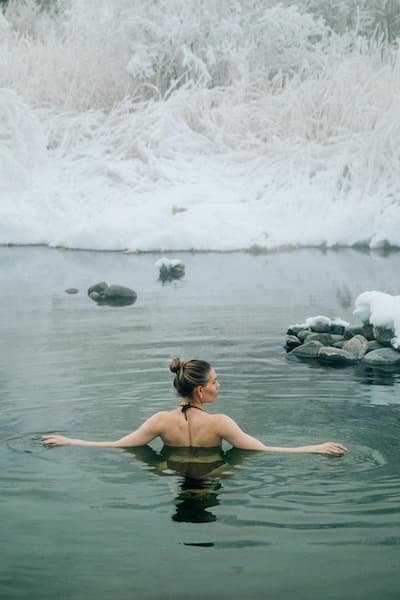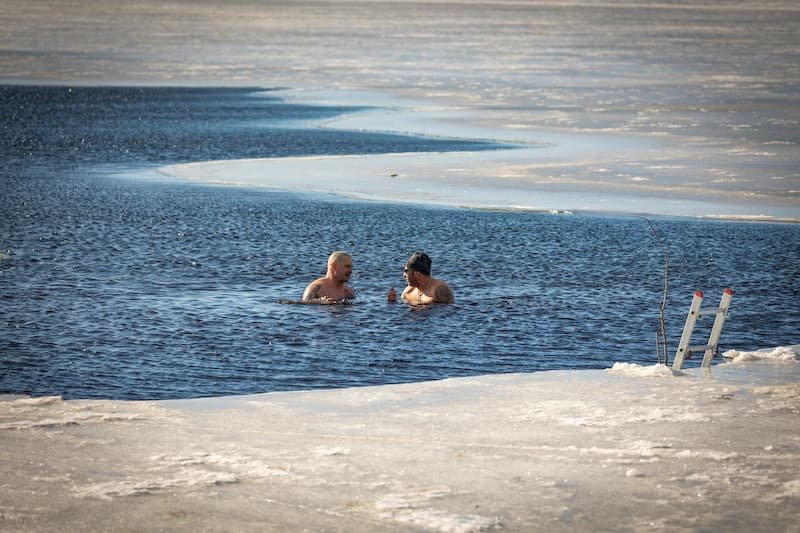
 Nick Pelios
Freediver, Creator
Nick Pelios
Freediver, Creator

 Nick Pelios
Freediver, Creator
Nick Pelios
Freediver, Creator
The freediving world is full of paradoxes. Divers go deeper by relaxing more. They move better by resisting less. And sometimes, to perform better in warm, clear tropical waters, they train in icy, bone-chilling conditions. Cold water plunges have long been part of fringe wellness routines and elite sports recovery protocols. But a growing number of freedivers are now using them intentionally, as part of a broader strategy to improve breath-hold, mental resilience, and overall underwater performance.
So what does plunging into water just above freezing have to do with diving 60 meters on a single breath? More than you might expect.
The moment your body hits cold water, everything changes. Your blood vessels constrict. Your heart rate spikes. Your breath catches. The sympathetic nervous system, the body's fight or flight mode, is instantly triggered. In the world of freediving, this is the opposite of what you want before a dive. And that is precisely why it can be such a powerful training tool.
Cold water plunges train your body and your mind to stay calm under stress. Regular exposure teaches the nervous system to adapt, making it easier to maintain control when it matters most, during a deep dive when the pressure is rising and time feels tight.
Freedivers who integrate cold exposure report improvements in their ability to manage pre-dive anxiety, discomfort at depth, and post-dive recovery. Some even say it helps them stay more present and mindful during their breath-hold, something that often separates a clean dive from a black-out.
Cold water activates the mammalian dive reflex, the same physiological response that slows your heart rate, redirects blood to vital organs, and helps conserve oxygen when you dive. This response is stronger in colder water, especially when the face is submerged. Training it through cold plunges can enhance your ability to trigger and maintain this reflex during actual dives.
When used correctly, cold exposure becomes a kind of dryland simulation for depth training. It primes the reflexes, conditions the vascular system, and builds tolerance for the discomfort of contractions. All without needing to leave the shore.

There is also a psychological edge. Cold plunges are uncomfortable, every single time. But committing to them regularly trains discipline, mental fortitude, and the ability to override the urge to escape. These are exactly the same traits you need when your body tells you to breathe at 40 meters, but you know you can make it back.
Beyond the mind, cold water has well-documented physical benefits. It reduces inflammation, boosts circulation, and supports recovery between training sessions. Freedivers dealing with heavy leg fatigue from pool dynamics or intense strength training can use cold immersion to bounce back quicker. And better recovery means more consistent training, which ultimately leads to better performance.
Cold water exposure comes in many forms. Some divers use commercial ice baths or high-end recovery tubs. Others take the rustic route, plunging into alpine lakes, mountain streams, or the sea at dawn. Even a cold shower can start to condition the system, although the immersion effect is significantly stronger.
What is important is consistency and control. Start with short durations, always prioritize safety, and focus on the breath. Long exhales, calm inhales, and relaxed awareness are the goal. This is not about suffering. It is about adaptation.

While it is tempting to associate cold plunges with elite athletes or adrenaline junkies, the truth is, any freediver can benefit from smart exposure. Beginners often struggle with tension and mental noise. Cold immersion, practiced regularly and mindfully, can create space to confront and reduce that stress response.
Instructors are starting to include it in pre-dive routines or recovery protocols. Schools in colder regions already treat cold tolerance as part of foundational freediving education. And as freediving expands into more diverse locations, from Norway to Canada to South Korea, cold is becoming less of an obstacle and more of an ally.
Research into cold exposure is booming. Studies show that regular immersion improves vagal tone, heart rate variability, and stress resilience. These are all markers of parasympathetic nervous system strength, the very system freedivers rely on to achieve long, efficient breath-holds.
Cold plunges also appear to increase brown fat activity, which improves metabolic efficiency and temperature regulation. While not directly related to freediving, this increased resilience can help in colder dive environments or long surface swims.
There is also promising data around immune function, dopamine release, and mental health benefits, all of which support the kind of holistic wellness that serious freedivers often pursue.
If you are new to cold plunging, here are some key guidelines:
1. Start with water around 10 to 15 degrees Celsius for 1 to 2 minutes.
2. Gradually increase time, but never push through pain or numbness.
3. Always warm up naturally afterward. Avoid hot showers right away.
4. Stay mindful. Focus on your breath and stay present.
5. Never plunge alone.
Used properly, cold exposure can be a powerful tool. Misused, it can be dangerous. Respect is non-negotiable, just like with freediving.
Cold water plunges will not replace depth training, breathwork, or technique refinement. But they can sharpen the tools you already have. They teach you to befriend discomfort. To breathe through fear. To calm your system when everything is screaming for panic. And maybe, just maybe, that extra moment of calm is what helps you equalize deeper, stay longer, and surface cleaner. In freediving, the limits are internal long before they are physical. Cold water teaches you to meet those limits face to face and pass through them.